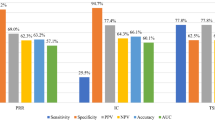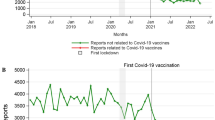Abstract
Background: A rarely used opportunity in pharmacovigilance is data mining for adverse drug reactions (ADRs) in population-based healthcare databases.
Objective: To evaluate the potential of data mining for ADRs in the nationwide Danish healthcare databases. We specifically considered hospital contacts following measles, mumps and rubella (MMR) immunization.
Methods: We constructed a cohort consisting of all children born in Denmark from 1995 to 2007 (n = 918 831) with individual-level linked data on childhood vaccinations and hospital contacts from the nationwide Danish healthcare databases. We applied a cohort-based data mining methodology to compare the observed versus the expected incidence of adverse event in different time periods relative to immunization. With this approach we evaluated temporal associations between MMR immunization and 5915 different diagnoses occurring in the cohort. In order to evaluate the ability of our approach to detect signals, we singled out a set of four adverse events previously recognized as being associated with the MMR vaccine.
Results: We were able to link a total of 3 162 251 hospital contacts and 5915 different diagnoses to the children in the cohort. Previously recognized temporal associations between adverse events (febrile convulsions, idiopathic thrombocytopenic purpura, lymphadenopathy and rash) and MMR immunization were identified in the Danish databases by our method.
Conclusions: Data mining in the Danish population-based healthcare databases provides adequate ability to detect adverse events. Pharmacovigilance using electronic healthcare databases holds potential as an important supplement to traditional pharmacovigilance.





Similar content being viewed by others
References
Centers for Disease Control and Prevention (CDC). Intussusception among recipients of rotavirus vaccine: United States, 1998–1999. MMWR Morb Mortal Wkly Rep 1999 Jul 16; 48(27): 577–81
Murphy TV, Gargiullo PM, Massoudi MS, et al. Intussusception among infants given an oral rotavirus vaccine. N Engl J Med 2001 Feb 22; 344(8): 564–72
Major EO. Reemergence of PML in natalizumab-treated patients: new cases, same concerns. N Engl J Med 2009 Sep 10; 361(11): 1041–3
Berlin JA, Glasser SC, Ellenberg SS. Adverse event detection in drug development: recommendations and obligations beyond phase3. Am J Public Health 2008 Aug; 98(8): 1366–71
Hallas J. Conducting pharmacoepidemiologic research in Denmark. Pharmacoepidemiol Drug Saf 2001 Dec; 10(7): 619–23
Malig C. The civil registration system in Denmark. IIVRS technical paper. Bethesda (MD): International Institute for Vital Registration and Statistics, 1996. Report no. 66
Hviid A. Postlicensure epidemiology of childhood vaccination: the Danish experience. Expert Rev Vaccines 2006 Oct; 5(5): 641–9
Andersen TF, Madsen M, Jorgensen J, et al. The Danish National Hospital Register: a valuable source of data for modern health sciences. Dan Med Bull 1999 Jun; 46(3): 263–8
Norén GN, Hopstadius J, Bate A, et al. Temporal pattern discovery in electronic patient records. Data Min Knowl Discov 2010; 20(3): 361–87
DuMouchel W. Bayesian data mining in large frequency tables, with an application to the FDA spontaneous reporting system. Am Stat 1999; 3(53): 177–202
Bate A, Lindquist M, Edwards IR, et al. A Bayesian neural network method for adverse drug reaction signal generation. Eur J Clin Pharmacol 1998 Jun; 54(4): 315–21
Vestergaard M, Hviid A, Madsen KM, et al. MMR vaccination and febrile seizures: evaluation of susceptible subgroups and long-term prognosis. JAMA 2004 Jul 21; 292(3): 351–7
Miller E, Waight P, Farrington CP, et al. Idiopathic thrombocytopenic purpura and MMR vaccine. Arch Dis Child 2001 Mar; 84(3): 227–9
Jefferson T, Price D, Demicheli V, et al. Unintended events following immunization with MMR: a systematic review. Vaccine 2003 Sep 8; 21(25–26): 3954–60
Plotkin SA, Reef ER. Rubella vaccine. In: Plotkin SA, Orenstein WA, Offit PA, editors. Vaccines. 5th ed. Philadelphia (PA): Saunders, 2008: 735–71
Strebel PM, Papania MJ. Measles vaccine. In: Plotkin SA, Orenstein WA, Offit PA, editors. Vaccines. 5th ed. Philadelphia (PA): Saunders, 2008: 353–98
Edwards R, Faich G, Tilson H. Points to consider: the roles of surveillance and epidemiology in advancing drug safety. Pharmacoepidemiol Drug Saf 2005 Sep; 14(9): 665–7
Hazell L, Shakir SA. Under-reporting of adverse drug reactions: a systematic review. Drug Saf 2006; 29(5): 385–96
Stephenson WP, Hauben M. Data mining for signals in spontaneous reporting databases: proceed with caution. Pharmacoepidemiol Drug Saf 2007 Apr; 16(4): 359–65
Brewer T, Colditz GA. Postmarketing surveillance and adverse drug reactions: current perspectives and future needs. JAMA 1999 Mar 3; 281(9): 824–9
Hauben M, Patadia V, Gerrits C, et al. Data mining in pharmacovigilance: the need for a balanced perspective. Drug Saf 2005; 28(10): 835–42
Almenoff JS, Pattishall EN, Gibbs TG, et al. Novel statistical tools for monitoring the safety of marketed drugs. Clin Pharmacol Ther 2007 Aug; 82(2): 157–66
Brown JS, Kulldorff M, Chan KA, et al. Early detection of adverse drug events within population-based health networks: application of sequential testing methods. Pharmacoepidemiol Drug Saf 2007 Dec; 16(12): 1275–84
Greene SK, Kulldorff M, Lewis EM, et al. Near real-time surveillance for influenza vaccine safety: proof-of-concept in the Vaccine Safety Datalink Project. Am J Epidemiol 2010 Jan 15; 171(2): 177–88
Davis RL, Kolczak M, Lewis E, et al. Active surveillance of vaccine safety: a system to detect early signs of adverse events. Epidemiology 2005 May; 16(3): 336–41
Belongia EA, Irving SA, Shui IM, et al. Real-time surveillance to assess risk of intussusception and other adverse events after pentavalent, bovine-derived rotavirus vaccine. Pediatr Infect Dis J 2010 Jan; 29(1): 1–5
Lieu TA, Kulldorff M, Davis RL, et al. Real-time vaccine safety surveillance for the early detection of adverse events. Med Care 2007 Oct; 45 (10 Suppl. 2): S89–95
Hocine MN, Musonda P, Andrews N, et al. Sequential case series analysis for pharmacovigilance. J R Stat Soc Ser A 2009; 172(1): 213–36
Walker AM. Pattern recognition in health insurance claims databases. Pharmacoepidemiol Drug Saf 2001 Aug; 10(5): 393–7
Platt R, Madre L, Reynolds R, et al. Active drug safety surveillance: a tool to improve public health. Pharmacoepidemiol Drug Saf 2008 Dec; 17(12): 1175–82
Acknowledgements
No sources of funding were used to prepare this study. Torbjörn Callréus is a full-time employee of the Danish Medicines Agency. The views expressed in this study are the personal views of the authors and do not necessarily represent the position of the Danish Medicines Agency. None of the other authors have any conflicts of interest.
Author information
Authors and Affiliations
Corresponding author
Rights and permissions
About this article
Cite this article
Svanström, H., Callréus, T. & Hviid, A. Temporal Data Mining for Adverse Events Following Immunization in Nationwide Danish Healthcare Databases. Drug-Safety 33, 1015–1025 (2010). https://doi.org/10.2165/11537630-000000000-00000
Published:
Issue Date:
DOI: https://doi.org/10.2165/11537630-000000000-00000




